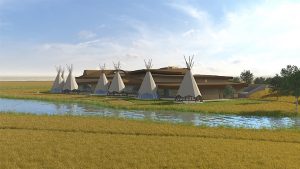Three years in the making
SHAKOPEE, MN— It took three years and $75 million, but Hocokata Ti, the Shakopee Mdewakanton Sioux Community’s (SMSC) new cultural center will open to the public on July 26, 2019. According to the SMSC website, the cultural center will be “a gathering space that will be used to interpret and encourage traditional Mdewakanton Dakota cultural heritage, language, and history by sustaining this inherent knowledge for SMSC members through exhibitions, preservation and education.”
The 92,500-foot structure will feature seven 40-foot high tipis, and a uniquely constructed building. Project manager for McGough Construction, Carolyn Wolf, said: “I don’t know of a single building like it. Every aspect of the space is unique, from the building materials to the floor pattern to the three-tiered roof system. There is only one 90-degree corner in the whole building enclosure. It’s truly a remarkable design.”
“Ho-cho-kah-tah-tee” means “the lodge at the center of the camp,” but in the years to come it will come to mean this facility, the crown jewel of SMSC’s wide-ranging, lucrative tribal empire, built from a tragic past and humble beginnings.
SMSC Chairman Charles R. Vig said: “It’s time to tell our story. The most important part of this building— besides our culture, our teachings, and our history— is it will help tell our story as Mdewakanton Dakota, to others.”
One of the seven council fires of the Oceti Sakowin, the Mdewakanton were at the center of the bloody 1862 conflict that resulted in hundreds of deaths, and the largest mass execution in US history (38 tribal leaders deemed accountable for the bloodshed). Beyond the specifics of that conflict, was the fate of a small band of Mdewakanton relocated on a 250-acre tract in the 1880’s. For the better part of a century they struggled, initially destitute, often impoverished, dependent upon an often indifferent federal government, but all of that changed starting in 1969, when the SMSC received federal recognition.
Little Six Bingo Palace opened in 1982, but it soon became Little Six Casino after it became obvious the real money was in other, more sophisticated forms of gambling and entertainment. By 1992, SMSC had perfected their casino model and expanded to the Mystic Lake Casino Hotel. The original 250-acre allotment, fortuitously located near a large metropolitan area, grew to 2,000 acres and the SMSC casino based enterprise generated great wealth for the 658-member tribe.
It took a couple of decades, but SMSC became a well-oiled economic machine, and are now the largest employer in Scott County. The Tribe did not forget their relatives and neighbors. They have been a critical force in economic development and philanthropy. They often provide the seed money for other tribes to pursue their own economic development.
Besides casinos, SMSC has a cooperative marketing agreement with Canterbury Park, a horse racing track. They have expanded into the retail business world and other businesses for a total of at least eighteen separate enterprises from shopping malls to fitness centers, convenience stores and recycling and water bottling facilities.
Over the years, SMSC has donated more than $350 million, putting the tribe at the forefront of Indian Country philanthropy. Fellow tribes have also received half a billion dollars in economic development loans.
Those tribes in close proximity to large metropolitan areas, whether Shakopee or Winnebago, have found themselves in a situation where gambling has often created tremendous profit, whereas fellow Dakota like the Santee of north central Nebraska, due to their remote location, cannot generate the patronage the SMSC enjoy to make their casinos take off. To be fair, other tribes in similar favorable locations, such as Flandreau and Omaha, but have failed to produce the economic success story of Shakopee.
The Hocokata Ti Cultural Center will offer a window into the rich history of the Oceti Sakowin, not just the SMSC history. There will be a 3,470-square-foot public exhibit, called Mdewakanton: Dwellers of the Spirit Lake, and there will be guided tours and displays of Dakota artifacts. Art, books, music, and craftwork will be available at the gift shop, which will be adjacent to the SMSC library. There will also be outdoor trails and public gardens, featuring plants culturally significant to the Dakota Oyate.
It’s probably more expensive to take the family to a movie, than to tour the facility. Adult admission is $7.50, children under twelve, $3.75, and seniors, veterans and students, $4.00.
(James Giago Davies is an enrolled member of the Oglala Lakota tribe. He can be reached at skindiesel@msn.com)

